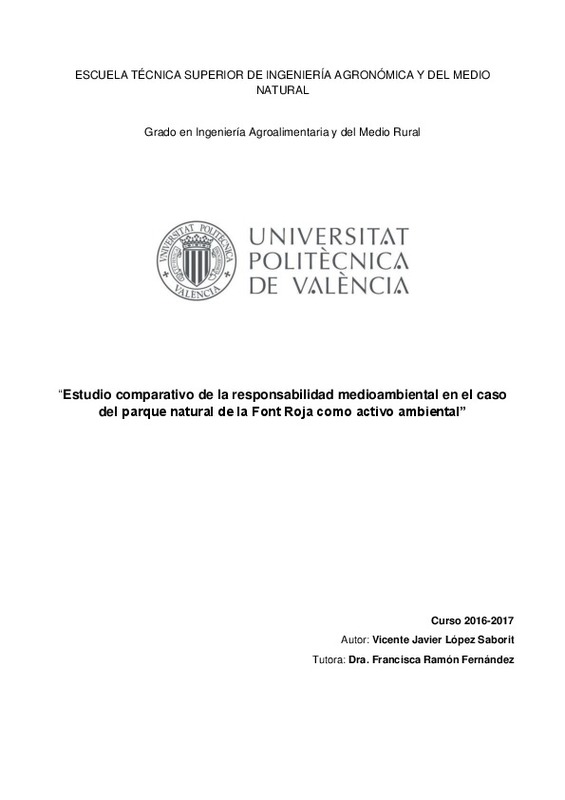|
Resumen:
|
[ES] La reciente revisión de la política medioambiental implementada por la Comisión Europea
(Environmental Implementatión Review: EIR por sus siglas en inglés) ha puesto de manifiesto una
deficiente aplicación de la ...[+]
[ES] La reciente revisión de la política medioambiental implementada por la Comisión Europea
(Environmental Implementatión Review: EIR por sus siglas en inglés) ha puesto de manifiesto una
deficiente aplicación de la legislación medioambiental de la Unión Europea. Esta situación produce
unos efectos muy negativos para la sociedad europea por los costes medioambientales, económicos
y sociales tan importantes que representa.
Los procesos de destrucción del capital natural y los cambios que alteran la calidad ambiental de los
ecosistemas y sus servicios conllevan significativos costes para la sociedad. Todo ello implica la
necesidad de disponer de información sobre el valor económico de los activos ambientales, para
poder determinar los costes de su reparación, compensación o contribución para generarlos, y así
poder repercutir los mismos de forma equitativa entre los que los degradan o se benefician de ellos
(Martínez y Flores, 2014)
La política medioambiental europea se basa en los principios de cautela, prevención, corrección de
la contaminación en su fuente, y de “quien contamina paga”. La orientación y el desarrollo normativo
de aplicación de la misma han adoptado una visión más sistemática y acorde con el enfoque y el
tratamiento de la problemática ambiental (medio ambiente versus actividad económica)
Un claro ejemplo es el régimen de responsabilidad medioambiental, introducido por la Ley 26/2007,
de 23 de octubre, de Responsabilidad Medioambiental, publicada en el Boletín Oficial del Estado
(BOE) núm. 255, de 24 de octubre de 2007, que transpone a nuestro ordenamiento jurídico la
Directiva 2004/35/CE del Parlamento Europeo y del Consejo, de 21 de abril de 2004, sobre
Responsabilidad Medioambiental en relación con la prevención y reparación de daños
medioambientales, publicada el 30 de abril de 2004 en el Diario Oficial de la Unión Europea (DOUE).
Las actividades económicas que ocasionen daños al medio ambiente deben devolver los recursos
naturales afectados su estado original y prevenir sus causas tomando las medidas necesarias para
evitarlo. En este sentido, la valoración del daño ambiental es el elemento clave para obtener una
efectiva reparación.
Para facilitar la tarea de determinar por parte de los operadores el valor económico de los potenciales
daños medioambientales, se ha desarrollado el proyecto denominado Modelo de Oferta de
Responsabilidad Ambiental (MORA). Se trata de una herramienta de valoración para calcular el valor
de reposición de recursos naturales cubiertos por esta normativa: suelo, agua, hábitat, especies, y
ribera del mar y de las rías, aplicando para ello métodos económicos basados en la curva de la oferta.
Su objetivo principal es estimar el orden de magnitud del coste de reposición, expresado en unidades
monetarias, de estos recursos naturales que hipotéticamente pueden resultar dañados o ya la han
sido.
[-]
[EN] The recent review of the environmental policy implemented by the European Commission (EIR) has
revealed poor implementation of European Union environmental legislation. This situation has a very
negative effect on ...[+]
[EN] The recent review of the environmental policy implemented by the European Commission (EIR) has
revealed poor implementation of European Union environmental legislation. This situation has a very
negative effect on European society because of the significant environmental, economic and social
costs it represents.
The processes of destruction of natural capital and changes that alter the environmental quality of
ecosystems and their services entail significant costs for society. All this implies the need to have
information on the economic value of environmental assets, in order to determine the costs of
repairing, compensating or contributing to generate them, and thus be able to pass them on equitably
among those who degrade or benefit from them.
European environmental policy is based on the principles of caution, prevention, correction of pollution
at source, and "polluter pays". The orientation and the normative development of its application have
adopted a more systematic and in accordance with the approach and the treatment of environmental
problems (environment versus economic activity)
A clear example is the regime of environmental liability, introduced by Law 26/2007, of October 23,
Environmental Responsibility, published in the BOE no. 255 of 24 October 2007, which transposes
Directive 2004/35 / EC of the European Parliament and of the Council of 21 April 2004, on
environmental liability in relation to the prevention and remedying of environmental damage,
published on April 30, 2004, in the Official Journal of the European Union.
Economic activities that cause damage to the environment must return the natural resources affected
to their original state and prevent their causes by taking the necessary measures to avoid it. In this
sense, the assessment of environmental damage is the key element to obtain an effective repair.
In order to facilitate the task of determining the economic value of potential environmental damage,
the project called the Environmental Liability Supply Model has been developed. It is a valuation tool
to calculate the value of replenishment of natural resources covered by these regulations: soil, water,
habitat, species, and shore of the sea and estuaries, applying economic methods based on the supply
curve. Its main objective is to estimate the order of magnitude of the replacement cost, expressed in
monetary units, of these natural resources that can be hypothetically damaged or have already been
damaged.
[-]
|







